Students must practice this TS Inter 1st Year Maths 1B Study Material Chapter 10 Applications of Derivatives Ex 10(f) to find a better approach to solving the problems.
TS Inter 1st Year Maths 1B Applications of Derivatives Solutions Exercise 10(f)
Question 1.
Verify Rolle’s theorem for the following functions. (V.S.A.Q.)
(i) x2 – 1 on [-1, 1]
Answer:
Let f(x) = x2 defined on [-1, 1].
Since the function f(x) is a polynomial, it is continuous on [-1, 1] and differentiable on (-1, 1)
Also f(1) = 1 – 1 = 0, f(- 1) = (- 1)2 – 1 = 0
∴ f (-1) = f (1). Hence f satisfy all conditions of Rolle’s theorem. Now we have to find a point c ∈ (-1,1) such that f'(c) = 0, f'(x) = 2x and f'(c) = 0 ⇒ 2c = 0
⇒ c = 0 ∈ (-1, 1)
Hence Rolle’s theorem is verified.
(ii) sin x – sin 2x on [0, π]
Answer:
Let f(x) = sin x – sin 2x defined over [0, π] f is continuous over [0, π] and differentiable over (0, π).
Also f(0) = 0 and f(π) = sin π – sin 2π = 0
∴ f(0) = f(π) = 0.
Hence f satisfy conditions of Rolle’s theorem’.
Also f'(x) = cos x – 2 cos 2x and f’ (c) = 0
⇒ cos c – 2 cos 2c = 0
⇒ cos c = 2 (2 cos2c – 1)
⇒ 4 cos2c – cos c – 2 = 0
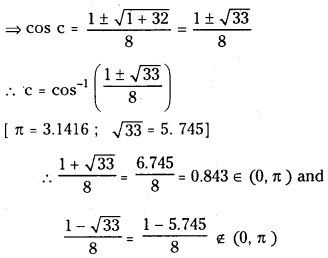
Hence conditions of Rolle’s theorem are verified.
(iii) log (x2 + 2) – log 3; over [-1, 1]
Answer:
f(x) = log (x2 + 2) – log 3
This function is continuous over [-1,1] and differentiable over (-1,1)
f (-1) = log (1 + 2) – log 3 = 0
f(1) = log 3 – log 3 = 0
f (-1) = f (1)
Hence f satisfy all the conditions of Rolle’s theorem. So we have to find c ∈ (-1,1)
such that f’ (c) = 0 and f’ (c) = 0
⇒ c = 0 ∈ (-1, 1)
So Rolle’s theorem is verified.
![]()
Question 2.
It is given that Rolle’s theorem holds for the function f(x) = x3 + bx2 + ax on [1, 3] with c = 2 + \(\frac{1}{\sqrt{3}}\). Find the values of a and b.
Answer:
Given that f(x) = x3 + bx2 + ax defined over [1, 3] satisfy all the conditions of Rolle’s theorem.
∴ f ’(x) = 3x2 + 2bx + a
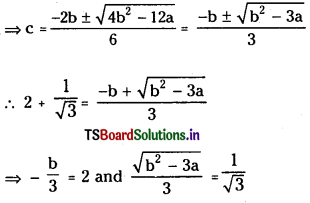
b = -6, and b2 – 3a = 3
⇒ 36 – 3a = 3 ⇒ a = 11
Hence a = 11 and b = – 6
Question 3.
Show that there is no real number k, for which the equation x2 – 3x + k = 0 has two distinct roots in [0, 1]. (S.A.Q.)
Answer:
Let f(x) = x2 – 3x + k and suppose there exists two different roots α, β (α < β). Since f is a polynomial in x, it is continuous over [0, 1] and differentiable in (0, 1). f is continuous over [a, 3] and differentiable in (a, β).
Also f(α) = α2 – 3α + k = 0 and
f(β) = β2 – 3β + k = 0
f(α) = f(β) = o :
f satisfy the conditions of Rolle’s theorem.
Also f'(c) = 0 ⇒ 3c2 – 3 = 0
⇒ c2 = 1
⇒ c = ± 1
This is a contradiction since
0 < α < c < β < 1
Hence there does not exists roots α, β in (0, 1).
So, there is no real number k for which the equation x2 – 3x + k = 0 has distinct roots in[0, 1]
Question 4.
Find a point on the graph of the curve y = (x – 3)2 where the tangent is parallel to the chord joining (3, 0) and (4, 1). (S.A.Q.)
Answer:
Let the points be A (3, 0) and B (4, 1)
∴ Slope of chord AB = \(\frac{1-0}{4-3}\) = 1
Given y = (x – 3)2
\(\frac{\mathrm{dy}}{\mathrm{dx}}\) = 2(x – 3)
Slope of the chord 2 (x – 3) = 1
⇒ 2x = 7 ⇒ x = \(\frac{7}{2}\)
∴ y = (x – 3)2 = (\(\frac{7}{2}\) – 3) = \(\frac{1}{4}\)
The point on the curve = \(\left(\frac{7}{2}, \frac{1}{4}\right)\)
![]()
Question 5.
Find a point on the graph of the curve y = x3 where the tangent is parallel to the chord joining (1, 1) and (3, 27). (S.A.Q.)
Answer:
Let the points be A (1, 1) and B (3, 27)
Slope of chord AB = \(\frac{27-1}{3-1}=\frac{26}{2}\) = 13
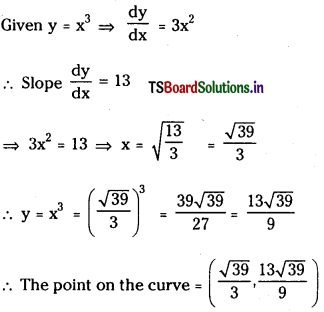
Question 6.
Find ‘c’ so that f'(c) = \(\frac{f(b)-f(a)}{b-a}\) in the following cases. (S.A.Q)
(i) f(x) = x2 – 3x – 1; a = \(\frac{-11}{7}\), b = \(\frac{13}{7}\)
Answer:
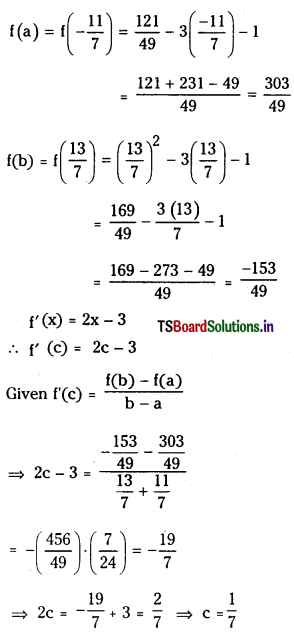
Question 7.
Verify the Rolle’s theorem for the function (x2 – 1) (x – 2) on [- 1, 2]. Find a point in the interval where the derivative vanishes. (S.A.Q.)
Answer:
Let f(x) = (x2 – 1) (x – 2)
= x3 – 2x2 – x + 2 defined over [-1, 2] f being a polynomial in ‘x’, it is continuous over [-1, 2] and differentiable over (- 1, 2) f (- 1) = 0, f(2) = 0 f(-1) = f(2)
∴ f satisfy all the conditions of Rolle’s theorem.
f'(x) = 3x2 – 4x – 1
and f'(c) = 0 ⇒ 3c2 – 4c – 1 = 0
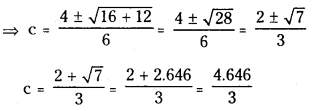
= 1.549 ∈ (-1, 2)
Rolle’s theorem is verified.
![]()
Question 8.
Verify the conditions of the Lagrange’s mean value theorem for the following functions. In each case find a point ‘c’ in the interval as stated by the theorem. (S.A.Q.)
(i) x2 – 1 on [2, 3]
Answer:
Let f(x) = x2 – 1 defined over [2, 3]. This being a polynomial in x, continuous on [2,3] and djfferentiable over (2,3). So by Lagrange’s mean value theorem there exists a point ‘c’ ∈ (2, 3) such that
f'(c) = \(\frac{\mathrm{f}(3)-\mathrm{f}(2)}{3-2}\)
f'(x) = 2x ⇒ f'(c) = 2c f(3) = 8, 1(2) = 3
∴ 2c = \(\frac{8-3}{1}\) = 5 ⇒ c = \(\frac{5}{2}\) ∈ (2, 3)
(ii) sin x – sin 2x on [0, π]
Answer:
Let f(x) = sin x – sin 2x defined over [0, π]. This is continuous on [0, π] and differentiable over (0, π) since
f’ (x) = cos x – 2 cos 2x exists for all x ∈ (0, π). So by Lrgrange s mean value theorem
f'(c) = \(\frac{\mathrm{f}(\pi)-\mathrm{f}(0)}{\pi-0}\), f(π) = 0, f(0) = 0
∴ cos c – 2 cos 2c = \(\frac{0}{\pi}\) =0
⇒ cos c – 2 cos 2c = 0
⇒ cos c – 2 (2 cos2 c – 1) = 0
⇒ 4cos2 c – cos c – 2 = 0
⇒ cos c = \(\frac{1 \pm \sqrt{1+32}}{8}=\frac{1 \pm \sqrt{33}}{8}\)
∴ c ∈ cos-1\(\left(\frac{1+\sqrt{33}}{8}\right)\) ∈ (0, π)
(ii) log x on [1, 2]
Let f(x) = log x defined over [1,2]
This is continuous over [1, 2] and differentiable over (1, 2) since
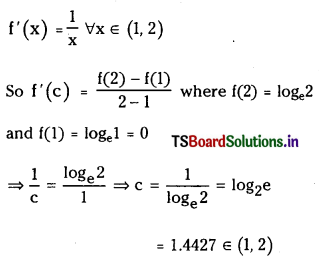
Hence Lagrange’s mean value theorem is satisfied.